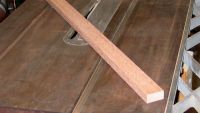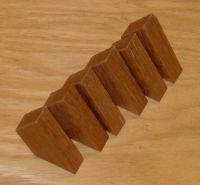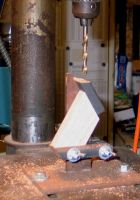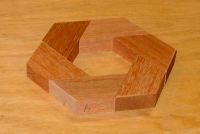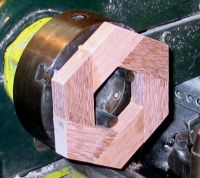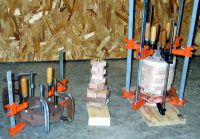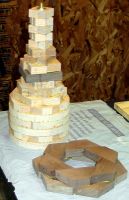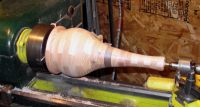| Dexter
Dogwood How It's Done |
Most
of the pieces of my pieces come from 3/4 x 1 1/2 inch stock (also known
as 1 x 2). After the edges are planed true, blocks can be cut. |
|
The
blocks are cut on my table saw. By flipping the stock each cut the pieces
are trapezoids and will fit together to form rings. |
|
This
home made fixture allows me to drill holes for dowel pins at a steep
angle. More on why pins are used in the next box. |
|
The
trick to getting an asymmetrically shaded look (one side of the piece
is always darker than the other no matter what angle it is viewed from,
usually the right) is asymmetrical grain orientation. Click the image
at right for more about ring assembly. |
|
This
ring is ready for the last step, truing both sides flat. This process
also removes the excess glue on and around the joints. |
|
Here
the rings have been stacked and clamped. On the left is the base, center
is the upper part (the lamp tubing acts as the clamp) and at right is
the lower part (assembled and clamped upside down) |
|
The
upper and lower parts have been glued and the piece is ready for turning.
The base will be turned and finished separately. |
|
Turning
is the fun part but it takes the least amount of time. After four days
of making the blank (mostly spent waiting for glue to dry), it took
me about an hour to turn this piece, then about two to sand and burnish. |
|
After
completing the base, both it and the lamp are remounted in the lathe,
which is covered and taped. With the lathe on its slowest speed (36
rpm) I apply the finish (two coats of natural stain and several coats
of lacquer). This prevents runs and drips. |
|
The
finished piece. |
